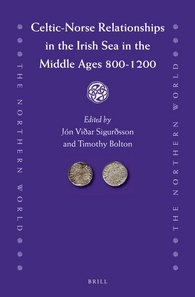Celtic-Norse Relationships in the Irish Sea in the Middle Ages 800-1200, Jón Vidar Sigurdsson and Timothy Bolton (eds.)
The Northern World Series Volume 65
Brill Academic Publishers, Leiden, Boston 2014
ISBN: 978-90-04-25511-1
Hardcover, with illustrations in black and white, bibliography and index
223 pages
€109,00 / $141,00
Celtic-Norse relations in the medieval period
This volume in Brill’s Northern World series derives from a conference of the same name held in Oslo in 2005, with the aim of bringing together the scholars working in the field of Celtic-Norse connections in the Middle Ages, in order to share with each other the latest research and knowledge of the subject. The papers from the conference, augmented and updated, together with a few extra articles, have been brought together in this 56th volume of the Northern World series. Contributions consist mainly of historical and archaeological articles, along with some art-historical and cultural-literary excursions. Jón Sigurdsson, professor of History at the University of Oslo, and Timothy Bolton, independent scholar and author of a monograph on Cnut the Great, took up the task to bring together and edit the collection of articles.
Clare Downham first gives an overview of Viking settlement in 8th- to 10th-century Ireland, thereby pointing out the cultural influence the Vikings had on the native population, and stressing that not all of these Viking-appearing settlements have to be truly founded by Norse invaders. Aspects of Norse culture became dominant and were taken over by the native population.
Colmán Etchingham follows with an investigation into the medieval annals of Ireland and Wales and their mentioning of ‘white’ and ‘dark’ groups of Vikings. He concludes the ‘white’ Vikings referred to the older settled groups of Norwegians, compared to the ‘black’ newcomers that were the Danes.
Fiona Edmonds then presents an interesting case study of three saint cults in Western Scotland; those of St. Brigit, St. Bega and St. Sanctán. Her conclusions support the general trend discovered by Collingwood that Scandinavian colonists in these areas developed a bonding with Irish saints and carried this affinity to the shores of Southwest-Scotland and Northwest-England.
A contribution on the similarities and differences between the kingdom of Man and the earldom of Orkney by Barbara Crawford is next. In this interesting article she shows the precarious situation in which the earls and kings found themselves during the medieval period, sometimes torn by dividing loyalties between the Norwegian, Scottish or English kings. Also the nature of their relationship to these more powerful neighbours is treated.
Ian Beuermann shows how the creation of medieval royal saints in the Irish Sea-region was very much a political affair. It turns out to be that when the time and conditions seemed ripe in 12th-century Man, the bad relationship between the ruling royal dynasty and the bishop in office prevented the creation of a Manx/Isles royal martyr cult.
David Wyatt deals with the continuing slave raiding and trading that occurred in Irish, Welsh and Scottish society after the Norman take-over of power from the Anglo-Saxons in England. He traces the roots of the Anglo-Norman aversion to this enslavement tactics to the upcoming ideals of chivalry and moral reform, as preached by the Church.
Jan Erik Rekdal then focuses on the intermingling of Norse and Celtic culture on the island of Man. The erection of stone crosses with a shared Norse pagan and an Irish christian imagery shows how the Norse newcomers took over the Irish tradition of the making of stone crosses but projected their own traditional mythology on it.
In the next article, Alan Lane thoroughly shows that the arrival of the Vikings in the Hebrides can be seen clearly in the very distinct type of pottery that was used. Until the Viking arrival, there was no marked difference in pottery styles from the Middle and Late Iron Age onwards.
In her contribution Zanette Glorstad shows that not only the Irish and insular places where the Viking newcomers settled were transformed by them, also because of this encounter with the new lands the Viking homeland was transformed by the incorporation and adoption of new products and customs. At the same time, this caused a lasting change of perception of the world by the people remaining at home in Norway. The ‘strange’ things from the outside world became known and therefore weren’t strange anymore, thus changing people’s worldview.
Julie Lund in her article describes how the Vikings in Ireland used the symbolic disposition of weapons on marked locations in the landscape as a way of giving meaning to that landscape, as was done in the Scandinavian homeland. By way of depositing these weapons, through their meaning the landscape also got meaning, thus restructuring it for their Norse inhabitants.
John Hines closes with a literary approach in which he studies the evolution of the medieval tale of king Havelok, whose story was used and adapted time and again throughout the Middle Ages, in Middle English and Old French, borrowing motives and names from the neighbouring Celtic tradition.
Viewing over the whole collection of articles in this compilation the great diversity is what strikes most. A lot of research has been bunched in the volume and it truly is a pleasure to plunge into all the different aspects of Celtic-Norse connections that are presented here. A recommended book for everyone interested in the Scandinavian and Celtic areas during the Middle Ages.
Wouter van Dijk

